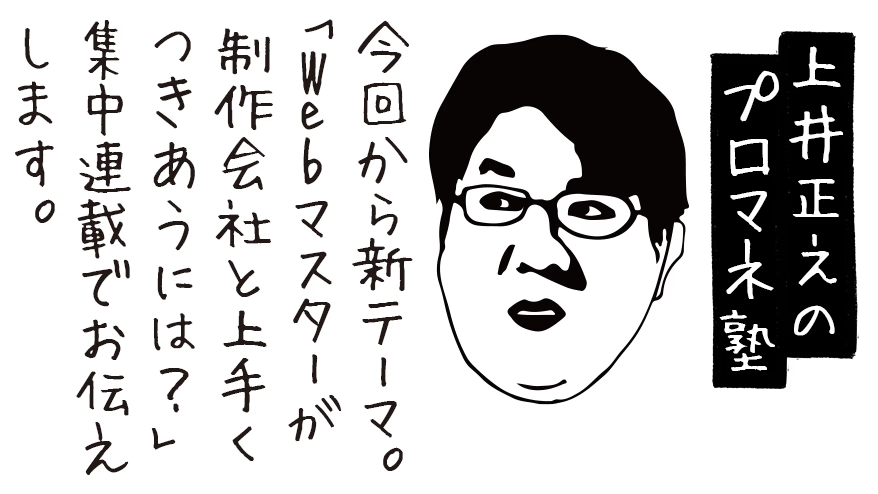こんにちはプロデュース部の上井です。
今回で9回目となる「プロマネ塾」の連載。
第7回と第8回では「設計とプロジェクトのQCD」と題して、建設分野で実践してきた設計のプロセスについてご紹介しました。
建設業界では、「基本計画(計画立案)」「基本設計(一般設計・施工費算出)」「詳細設計(実施設計)」「製造、施工」の手順でプロジェクトが進められますが、これは、システム開発の工程(ソフトウェアの開発モデル)と同様でした。
プロジェクトの組み立て方は、分野によらず変わらないことがわかります。
<図>建設業界の工程

※公共事業では、設計・施工分離の原則により契約3と4が分離発注となるのが一般的であるが、近年では施工者が持つ固有技術の活用を目的として、契約3と4を一括発注するケースもある。
<図>システム開発の工程

さて、今回からは、私たちモノサスが携わっているWeb制作の分野に話をもどしたいと思います。
急速に進む、インターネット利用環境の二分化
私がWebサイトの開発・制作に携わるようになったのは、建設業界からシステム開発会社に転職した17年前のことです。時期としては、ADSLの普及により個人宅でもPCによるインターネット利用が普及し始めたころで、企業のWebサイトは、大手企業や学校、行政機関を除けば、会社案内のパンフレットをWebに置き換えた、数ページ〜20ページの名刺代わりのサイトが多くを占めていたころです。
そんな中で、業務管理で利用しているデータをデータベース化して、製品情報などを動的に情報発信するコーポレートサイトや独自開発のECサイト、保護者向けの掲示板機能などを持たせた学校のサイトなど、中堅企業や学校によるWebシステム活用の機運が高まっており、それらのシステム構築に携わってきました。
その後、広告制作会社のWeb制作部門、そしてWeb制作会社であるモノサスへと所属を変えながらもWeb制作・開発に関わってきました。広告制作会社ではシステム開発部門と連携して、PCとフィーチャーフォンを対象としたインスタントウィンキャンペーンサイトの構築、数万人の登録会員を持つ会員向けサイトのリニューアル、大手メーカーやメーカーの系列販売会社のCMS入替えを伴うサイトリニューアルなど、インフラ構築やシステム開発と連携したプロジェクトで、PM業務やフロント側のPL業務を行ってきました。
このころ、PC向けサイトをW3C(World Wide Web Consortium)の勧告による「Web標準」に従って作成することが一般的となりました。この標準化の流れは、多くの企業、団体で自社サイトの見直し、リニューアルを促しました。また、サイト制作のみならず、ブラウザなどのアプリケーションの仕様にまで影響が及び現在に至っています。
そして、10年前のiPhone3Gの登場をきっかけに、携帯電話のスマートフォンへの移行が急速に進み、モバイルとPCでのインターネット利用に差がなくなっていきます。モバイルでのインターネット利用が、スマートフォンに変わることで、PCサイトとモバイルサイトを1つのサイトに集約することが可能となりました。また、企業ユーザーのインターネット利用はまだPCが主流ですが、一般ユーザーによる利用はスマートフォンが主流となってきています。
このように、インターネット利用環境の二分化が急速に進んでおり、現在のWebサイトには、この双方の要求に応えることが求められています。
発注者・受注者という関係性から「チーム」へ
Web標準化の浸透とスマートフォンの普及により、PC向けのサイトとモバイル向けのサイトを1つのHTMLで制作することができるようになりました。PC向けとは別にフィーチャーフォン向けのサイトを用意することと比べれば、モバイル向けのサイト構築のハードルは低くなりました。
しかし、以前のPCサイトのみを構築した場合と比較すると、技術面の難易度は上がり、制作工数も増大しています。
インターネットを取り巻く環境に目を移してみると、Webに関わる様々な分野で要求される技術の難易度が上がっているため専門性が高まり、職能の細分化が進んでいます。(サーバー、ネットワーク、セキュリティ対策、システム開発、データベース構築、コーディング、画面デザイン、UI/UX設計、画面設計、サイト設計、SEO、コンテンツ作成、コンテンツ企画、など)また、悪意ある第三者によるクラッキングや迷惑行為などの脅威が増大し、セキュリティ対策の重要性が高まっています。
サイトリニューアルにおいて、これら全てに対応するために、複数分野の技術に関する知見と対応力が求められています。そのため、サイトリニューアルのプロジェクトでは、何かしらの課題を残してしまうことが多くなってきているように感じます。もちろん、制作側の問題もありますが、クライアント側のWebマスターが「ここを理解しておいてもらえると、スムーズに進められたのに」と思うことがあります。
Webリニューアルのプロジェクトをスムーズに進めるには、クライアント側のWebマスターと制作側のプロジェクトマネージャーの協調が必要です。制作側が、クライアントの要望を理解しプロジェクトチームを統制できていることが最も重要であることに違いありません。しかし、制作・開発プロジェクトをスムーズに進めるには、クライアント側の理解、協力が欠かせません。
クライアント側のWebマスターへ、発注者・受注者という関係性のみならず、プロジェクトチームを共に率いる者として押さえておいてもらいたいことを、短期集中連載の形でお伝えしたいと思います。
今後、お伝えしていくこと
次回からは、大きくわけて5つの内容についてお伝えしていきます。
1. 予算の組み方について
コーポレートサイトのリニューアルでは、制作会社を指名コンペ形式で選定するのが一般的になってきています。
この際に、コンペ提案時の見積りに基づいて一括請負による受発注とされるケースが多く見られますが、ここには大きなリスクが潜んでいます。
<図>一括請負の受発注

プロジェクトスタート後、詳細な現状把握と設計を進める中で、受発注時の制作条件と異なる対応が必要となった場合に、費用とスケジュールの見直しについて、発注者と制作会社の間でのトラブルにつながることがあります。
これについては、次回の記事「第1回:(仮題)QCDの精度と予算」で、お伝えしたいと思います。
2. 要望の出し方について
コンペ参加時のRFPなどで示された要求仕様に従って、プロジェクトをスタートし設計、デザインなどを進行し合意を得たにも関わらず、制作工程、テスト工程で要求仕様の変更を求められることも散見されます。
手戻りによる、費用、スケジュールへの影響もありますが、アサインされた技術者では対応できない仕様への変更の場合、リソース手配などにより深刻な問題につながる可能性も出てきます。
3. スケジュールの組み方について
1.、2.であげたトラブルですが、設計工程でのクライアントによる確認が十分に行われていなかったり、承認の手続きが正しく行われていなかったことが原因となっていることが多いと感じています。
「2.要望の出し方」「3.スケジュールの組み方」については、「第2回:(仮題)上流工程(設計フェーズ)の進め方」でお伝えします。
4. リスク対応とコストのバランスについて
悪意ある第三者によるクラッキングや迷惑行為などの脅威が増大し、セキュリティ対策の重要性が高まっています。インターネットを支える技術は日々変化しているため、サーバーのOSやミドルウエア、システム開発言語、Webアプリケーション、ブラウザーなどに、バグや未知の脆弱性が残っていることが当たり前になっています。これらのリスクへの対応方針は、サイト管理の責任者であるWebマスターが決めなければなりません。
コストのバランスを考えたリスク対応の考え方について、「第3回:(仮題)セキュリティ対応と保守・運用について」で、お伝えします。
そして、「第4回:(仮題)上流工程でのWebマスターの役割と設計者に求められるスキルについて」では、1〜4を統括する予定です。
次回からの集中連載では、発注者であるWebマスターと制作会社が協力して、これらのリスクをどのように克服していけば良いのかを、考えていきたいと思います。
連載予定(タイトルは仮題)
第1回:QCDの精度と予算
第2回:上流工程(設計フェーズ)の進め方について
第3回:セキュリティ対応と保守・運用について
第4回:上流工程でのWebマスターの役割と設計者に求められるスキルについて
第5回:プロジェクト規模とリソースについて
第6回:ウォーターフォールモデルとアジャイル開発。
